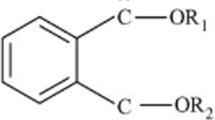Abstract
We have developed a gas chromatography-mass spectrometry (GC–MS) method to determine five phthalate monoesters (monoethyl phthalate (MEP), mono-n-butyl phthalate (MBP), mono-(2-ethylhexyl) phthalate (MEHP), monoisononyl phthalate (MINP) and monobenzyl phthalate (MBz)) in human urine. Human urine samples were subjected to enzymatic deconjugation of the glucuronides followed by extraction with hexane. The extracted phthalate monoesters were methylated with diazomethane, purified on a Florisil column and then subjected to GC–MS analysis. The recoveries from urine spiked with five phthalate monoesters were 86.3%–119% with coefficients of variation of 0.6%–6.1%. We measured phthalate monoester levels in human urine by analyzing 36 samples from volunteers. MBP and MEP were detected in all samples, and their median concentrations were 60.0 and 10.7 ng/mL, respectively. MBzP and MEHP were found in 75% and 56% of samples, and their median concentrations were 10.9 and 5.75 ng/mL, respectively. MINPs were not detected in most samples (6% detectable). Women had significantly (p < 0.05) higher mean concentrations of MBP and MEP than men. The estimated daily exposure levels for the four parent phthalates excluding diisononyl phthalate ranged from 0.27 to 5.69 μg/kg/day (median).

Similar content being viewed by others
References
Blount BC, Silva MJ, Caudill SP, Needham LL, Pirkle JL, Sampson EJ (2000a) Levels of seven urinary phthalate metabolites in a human reference population. Environ Health Perspect 108:979–982
Blount BC, Milgram KE, Silva MJ, Malek NA, Reidy JA, Needham LL, Brock JW (2000b) Quantitative detection of eight phthalate metabolites in human urine using HPLC-APCI-MS/MS. Anal Chem 72:4127–4134
Calafat AM, Needham LL, Silva MJ, Lambert G (2004) Exposure to di-(2-ethylhexyl) phthalate among premature neonates in a neonatal intensive care unit. Pediatrics 113:429–434
Ema M, Miyawaki E (2001a) Adverse effects on development of the reproductive system in male offspring of rats given monobutyl phthalate, a metabolite of dibutyl phthalate, during late pregnancy. Reprod Toxicol 15:189–194
Ema M, Miyawaki E (2001b) Effects of monobutyl phthalate on reproductive function in pregnant and pseudopregnant rats. Reprod Toxicol 15:261–267
Gray TJ, Gangolli SD (1986) Aspects of the testicular toxicity of phthalate esters. Environ Health Perspect 65:229–235
Green R, Hauser R, Calafat AM, Weuve J, Schettler T, Ringer S, Huttner K, Hu H (2005) Use of di(2-ethylhexyl) phthalate-containing medical products and urinary levels of mono(2-ethylhexyl) phthalate in neonatal intensive care unit infants. Environ Health Perspect 113:1222–1225
Hauser R (2008) Urinary phthalate metabolites and semen quality: a review of a potential biomarker of susceptibility. Int J Androl 31:112–117
Inoue K, Kawaguchi M, Yamanaka R, Higuchi T, Ito R, Saito K, Nakazawa H (2005) Evaluation and analysis of exposure levels of di(2-ethylhexyl) phthalate from blood bags. Clin Chim Acta 358:159–166
Itoh H, Yoshida K, Masunaga S (2005) Evaluation of the effect of governmental control of human exposure to two phthalates in Japan using a urinary biomarker approach. Int J Hyg Environ Health 208:237–245
Kawasaki T, Uezono K, Itoh K, Ueno M (1991) Prediction of 24-hour urinary creatinine excretion from age, body weight and height of an individual and its application. Jpn J Public Health 38:567–574
Koch HM, Drexler H, Angerer J (2003) An estimation of the daily intake of di(2-ethylhexyl)phthalate (DEHP) and other phthalates in the general population. Int J Hyg Environ Health 206:77–83
Kohn MC, Parham F, Masten SA, Portier CJ, Shelby MD (2000) Human exposure estimates for phthalates. Environ Health Perspect 108:A440–A442
Mortensen GK, Main KM, Anderson A-M, Leffers H, Skakkebæk NE (2005) Determination of phthalate monoesters in human milk, consumer milk, and infant formula by tandem mass spectrometry (LC-MS-MS). Anal Bioanal Chem 382:1084–1092
Mylchreest E, Cattley RC, Foster PMD (1998) Male reproductive tract malformations in rats following gestational and lactational exposure to di(n-butyl) phthalate: an antiandrogenic mechanism? Toxicol Sci 43:47–60
Parks LG, Ostby JS, Lambright CR, Abbott BD, Klinefelter GR, Barlow NJ, Gray LE Jr (2000) The plasticizer diethylhexyl phthalate induces malformations by decreasing fetal testosterone synthesis during sexual differentiation in the male rat. Toxicol Sci 58:339–349
Silva MJ, Barr DB, Reidy JA, Kato K, Malek NA, Hodge CC, Hurtz D 3rd, Calafat AM, Needham LL, Brock JW (2003) Glucuronidation patterns of common urinary and serum monoester phthalate metabolites. Arch Toxicol 77:561–567
Silva MJ, Barr DB, Reidy JA, Malek NA, Hodge CC, Caudill SP, Brock JW, Needham LL, Calafat AM (2004) Urinary levels of seven phthalate metabolites in the U.S. population from the National Health, Nutrition Examination Survey (NHANES) 1999–2000. Environ Health Perspect 112:331–338
Swan SH, Main KM, Liu F, Stewart SL, Kruse RL, Calafat AM, Mao CS, Redmon JB, Ternand CL, Sullivan S, Teague JL, Study for Future Families Research Team (2005) Decrease in anogenital distance among male infants with prenatal phthalate exposure. Environ Health Perspect 113:1056–1061
Acknowledgments
This study was supported by a grant from the Ministry of Health, Labor, and Welfare, Japan.
Author information
Authors and Affiliations
Corresponding author
Rights and permissions
About this article
Cite this article
Kondo, F., Ikai, Y., Hayashi, R. et al. Determination of Five Phthalate Monoesters in Human Urine Using Gas Chromatography-Mass Spectrometry. Bull Environ Contam Toxicol 85, 92–96 (2010). https://doi.org/10.1007/s00128-010-0051-8
Received:
Accepted:
Published:
Issue Date:
DOI: https://doi.org/10.1007/s00128-010-0051-8




